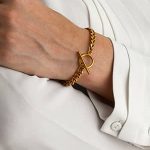Iran's 40s and 50s ornaments
Changes in the use of gold and jewelry in Iran's social classes in the 40s
With social changes in the 40s, three social groups with different views on gold and jewelry were formed.
1. Jewelry downstairs
The lower class of society usually used gold ornaments in small amounts. This group considered the use of gold distasteful for men and only allowed the use of jewelry for women in the presence of their wives. Therefore, jewelry designers and makers only designed for women and men had no place in this group.
In this class, most of the jewelry used included silver rings with agate and turquoise, and jewelry such as gold watches, tie pins, neck chains, bracelets, and hand plates had no place for men. For women, ornaments such as chains and breastplates with prayers or religious names were common. Much of the jewelry was made in Arabic and Indian style, and due to financial constraints, jewelry with light weight and simple design was preferred. Yellow gold was more valued than white gold, and white gold was considered a substitute.
Ornaments used downstairs:
- Long and famous pea chains, braided chains, snake chains
- Pendants and chest plaques with designs of hearts or Kaaba and religious prayers
- Pendants with agate stone or turquoise
- Pendants with agate stone or turquoise
- Wire and wide enameled bangles
- Hoop and Indian earrings
- Simple rings or with agate and turquoise
2. Jewelry in the middle class
The middle class, which made up the majority of society, was influenced by the intellectual and fashion changes brought about by the intellectuals. At first, these intellectuals came back from the Soviet Union with communist and anti-capitalist ideas and considered the use of gold and jewelry as a sign of showing off and luxury. These thoughts caused the use of ornaments in this class to decrease and the production of manufacturers was also limited.
Over time, the middle class, by traveling to Europe and America and learning about their developments, tended to use more modern ornaments. Organic designs inspired by nature became popular, such as flower-shaped rings and earrings with designs of birds and butterflies. Minkari and gold inlay also helped to create artistic works.
Ornaments used in the middle class:
- Rope chains, Rolex and Marie
- Pendants and chest plates with fancy designs and organic shapes
- Fancy rings and wedding rings with small diamonds
- Pearl and turquoise necklaces
- Chain and wide bracelets
- Fancy hoop earrings
- Wire and wide enameled bangles
3. Gold and jewelry in the wealthy class
The affluent class, which constituted the minority of society, enjoyed all the benefits of fashion changes and used luxurious and precious jewelry. By ordering luxurious and beautiful jewelry, with the help of precious stones such as diamonds, emeralds, rubies, and pearls, this group used to own very beautiful jewelry.
Ornaments used in the wealthy class:
- Fancy rings, enameled and jeweled with diamonds, emeralds and rubies
- Fancy and organic design earrings, enameled and jeweled
- Chain bracelets and jewelry
- Big and fancy chains
- Large pendants with jewelry
Conclusion
In the 40s, the use of gold and jewelry in different classes of Iranian society was influenced by social, cultural and economic factors. While the lower class used simple and light ornaments due to financial limitations and religious thoughts, the middle class gradually turned to modern and organic ornaments under the influence of intellectuals and fashion changes. The affluent class always used luxurious and precious jewelry and followed fashion changes more quickly.



